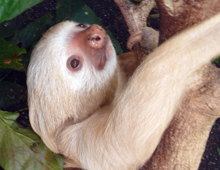Description: The shaggy hair of the Choloepus Hoffmanni (two-toed sloth) is always a solid color with no distinguishing markings. The paler face has shorter hair. The coarse, long wavy hair that covers the body varies from whitish-blonde to dark brown. The coat on the head, shoulders, and arms has a greenish cast, produced by algae growth on the hair shafts during the wet season. The short fur on the chest and abdomen parts in the middle and grows downwards towards the long hair on the back, ending in a long “drip-tip” at the end of the torso which allows the rain to run off. The mouth has only a slight smile under a protruding muzzle with a “pig-like” nose. The eyes are large and may have darker circles around them. The ears are large, fleshy and hairless – quite human-like! The fore and hind limbs are long and almost equal in length. The forelimbs have two hooked claws, the hind limbs have three, with long, hairless, fleshy pads on hands and feet. Most mammals have only seven neck bones (cervical vertebrate); Choloepus has five (less than the Bradypus (three-toed sloth)) and is able to tip its head backwards in a 90 degree angle. This enables it to look for danger as it climbs down its tree headfirst to use the bathroom!
Size: Adults are medium-sized animals; body length between 1.8 – 2.4 feet (0.6 -0.7 m); weight around 18 pounds (8 kg).
Behavior: Choloepus’ are solitary arboreal animals that eat, sleep, mate, and give birth while hanging from branches 90 feet up. Although considered nocturnal they are also active during daylight hours, and are more active than the Bradypus (three-toed sloth). Sloths are heterothermic –they must thermoregulate much like reptiles- and will move to the exposed upper branches of trees to increase their body temperature. They move down into the cooler interior branches when hot. This lifestyle is interrupted by a weekly trip to the base of their favorite trees to urinate and defecate. Graceful, adept, and nearly predator-free in the trees, they move as slowly on the ground as they do in trees, walking on all fours like other quadrupeds. While on the ground they are exposed to predation by the larger jungle cats and snakes. They cannot swim as well nor as far as the Bradypus (three-toed sloth). Their neck is very short, making it challenging to keep their head above water. They are much heavier and the hair absorbs water very quickly, causing them to drown quite easily. They swim with a dog-paddle stroke.
Diet: Choloepus’ diet consists of the leaves of up to 12 different species of trees, certain flowers, and an occasional unripe fruit. They have a very large, four-chambered stomach containing specialized enzymes and bacteria that allows for fermentation and the breakdown of cellulose into starches and sugars. It is well-documented that food will take around 30 days to pass through the entire digestive system.
Senses: Somewhat more active at night, they use all of their senses to forage for food.
Communication: Choloepus’ babies make a crying sound – “maa-maa” – when in distress, e.g. separation from mother. They are silent as adults, but when threatened they open and close their mouths, show their very sharp canines, and clack their teeth together repeatedly.
Reproduction: Females reach reproductive age at approximately two to three years; males are sexually mature between the ages of three and four. Gestation for Choloepus is about 11.5 months. One baby per gestation is the norm, however twins have been documented. They can become pregnant while nursing/caring for a baby. Mother carries her baby on her belly for up to a year and it nurses up to ten months. Baby begins to eat leaves at around a week and a half of age.
Habitat/range: Found in tropical forests in Central and South America, from Nicaragua to the Equator.
Status: IUCN Least Concern (LC); CITES Appendix III. Included in AZA Species Survival Plan®(SSP). This program cooperatively manages specific, and typically threatened or endangered populations.



